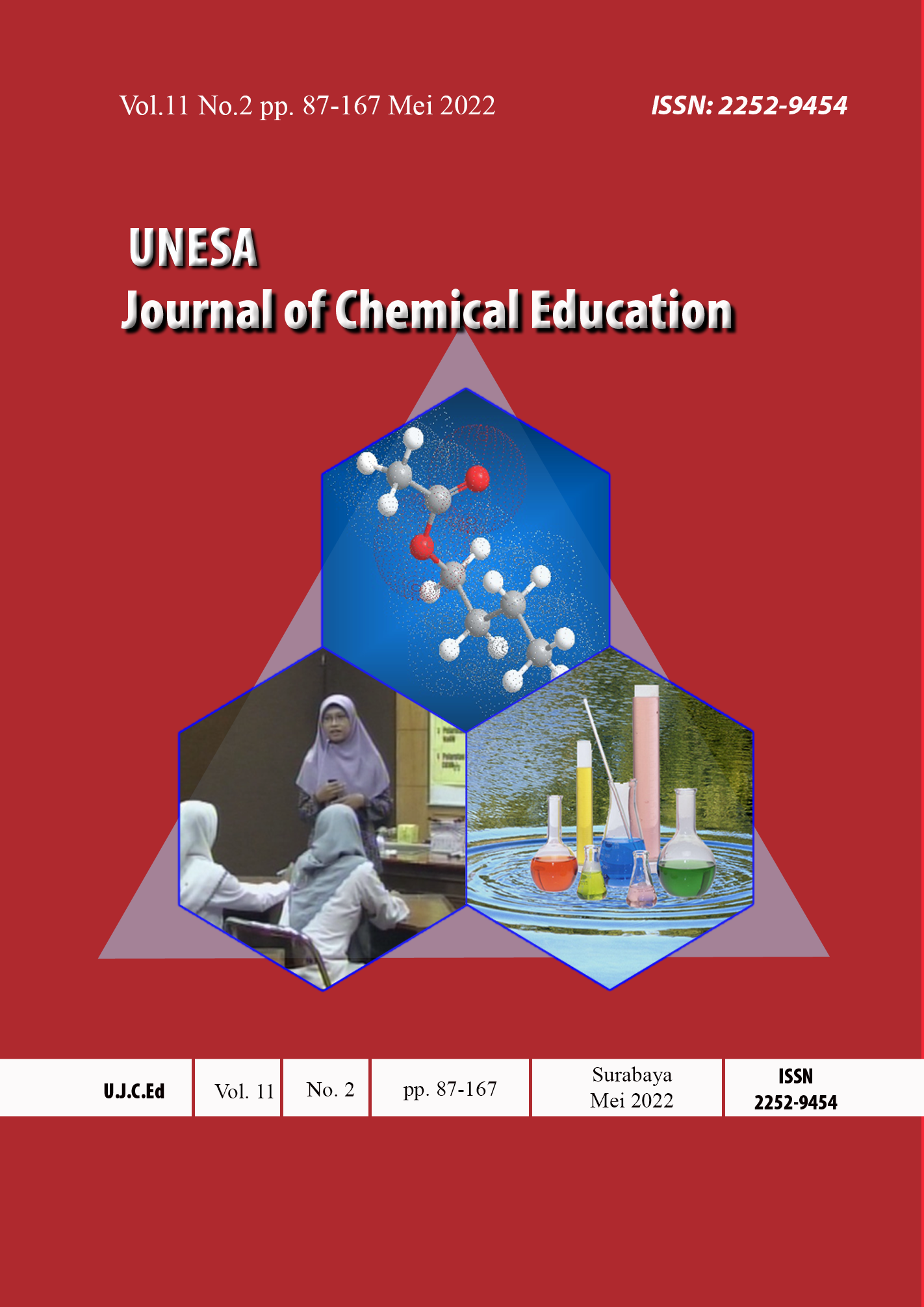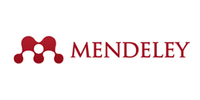DEVELOPMENT OF INTERACTIVE MULTIMEDIA TO PREVENT MISCONCEPTIONS IN SALT HYDROLYSIS MATERIALS
DOI:
https://doi.org/10.26740/ujced.v11n2.p95-103Keywords:
Interactive multimedia, misconceptions, HydrolysisAbstract
This study aims to determine the feasibility of interactive multimedia that used to prevent misconceptions on salt hydrolysis material in terms of validity, practicality, and effectiveness. The type of this study is Research and Development (R&D) of the ADDIE model which consists of five stages, namely analysis, design, development, implementation, and evaluation. And this research is only limited to the implementation stage. The trial or product implementation was carried out on 20 students of high school students of eleventh grade Science. Based on the results of the research, the percentage of construct validation is 86.8% and content validation is 85.8%. Percentage of practicality based on the student response questionnaires is 86.3% and the observation questionnaires is 89%. And percentage of effectiveness obtained based on student learning outcomes is 83.4%. Thus the results of this study indicate that the interactive multimedia developed is valid, practical, and effective used to prevent students' misconceptions on the salt hydrolysis material.
Downloads
References
Ristiyani, E. & Bahriah, E. S., 2016. Analisis Kesulitan Belajar Kimia Siswa di SMAN X Kota Tangerang Selatan. Jurnal Penelitian dan Pendidikan IPA, vol 2, no 1, pp. 18-29.
Upahi, J. E. & Ramnarain, U., 2019. Representations of Chemical Phenomena in Secondary School Chemistry Textbooks. Chemistry Education Research and Practice, vol 20, no 1, pp. 146-159.
Harianto, A., Suryani & Khrey, Y., 2017. Pengembangan Media Pembelajaran Kimia Berbasis Android untuk Penumbuhan Literasi Sains Peserta didik pada Materi Reaksi Redoks Ektrokimia. “Hydrogen” Jurnal Kependidikan Kimia, vol 5, no 4, pp. 35-47.
Arsyad, M. A., Sihaloho, M. & Kilo, A. L., 2017. Analisis Miskonsepsi pada Konsep Hidrolisis Garam Peserta Didik Kelas XI SMAN 1 Telaga. Jurnal Entropi, vol 11, no 2, pp. 190-195.
Ningkaula, T. A., Laliyo, L. A. R., Iyabu, H. & Abdullah, R., 2021. Dampak Model Discovery Learning Berpendekatan STEM Terhadap Pemahaman Konsep Hidrolisis Garam Siswa. Jurnal Pendidikan Kimia Indonesia, vol 5, no 2, pp. 76-84.
Maratusholihah, N. F., Rahayu, S. & Fajaroh, F., 2017. Analisis Miskonsepsi Peserta Didik SMA pada Materi Hidrolisis Garam dan Larutan Penyangga. “Jurnal Pendidikan” Teori, Penelitian dan Pengembangan, vol 2, no 7, pp. 919-926.
Pikoli, M., 2020. Using Guided Inquiry Learning with Multiple Representations to Reduce Misconceptions of Chemistry Teacher Candidates on Acid-Base Concept. International Journal of Active Learning, vol 5, no 1, pp. 1-10.
Suparno, P., 2005. Miskonsepsi dan Perubahan Konsep Pendidikan Fisika. Jakarta: Grasindo.
Mubarokah, F. D., Mulyani, S. & Indriyati, N. Y., 2018. Identifying Students’ Misconceptions of Acid-Base Concepts Using a Three-Tier Diagnostic Test: A Case of Indonesia and Thailand. Journal of Turkish Science Education, vol 15, Special Issue, pp. 51-58.
Fitria., Priatmoko, S. & Kasmui., 2016. Penggunaan Multimedia Interaktif dalam Meminimalisasi Miskonsepsi Siswa pada Materi Pokok Larutan Penyangga. Jurnal Inovasi Pendidikan Kimia, vol 10, no 1, pp. 1641-1650.
Marisda, D. H., Ramawati & Handayani, Y., 2020. The Combination of Interactive Conceptual Learning Models and Multimedia Interactive ti Minimize Misconceptions on The Science Content. “Journal of Physics” Conference Series, vol 01, no 20, pp. 69-75.
Elaine, E. & Andy, F., 2002. Interactive Media, What’s that and Who’s Involved?. London,UK: ATSF.
Sugiyono, 2011. Metode Penelitian Kuantitatif, Kualitatif, R&D. Bandung: Alfabeta.
Ridwan, 2015. Skala Pengukuran Variabel-variabel Penelitian. Bandung: Alfabeta.
Sa’adiyan, E. Z. & Sukarmin, 2021. Pengembangan Media Pembalajaran Interaktif C-Bonds untuk Mendeteksi dan Mereduksi Miskonsepsi dengan Strategi Change Text. Jurnal Kependidikan, vol 7, no 4, pp. 1039-1050.
Purba, J., Panggabean, F. T. M. & Widarma, A., 2021. Development of General Chemical Teaching Materials (Stoichiometry) in an Integrated Network of Media- Based Higher Order Thinking Skills. Advances in Social Science, Education and Humanities Research, vol 591, no 1, pp. 949-954.
Wiana, W. & Ruhidawati, C., 2020. Development of Virtual Textile Chemistry Laboratory in Learning Making Cellulose-Based Regeneration Fibers Based on Learning Paradigms in the Industrial Revolution 4.0 Era. International Journal for Innovation Education and Research, vol 8, no 11, pp. 52-64.
Drastisianti, A., Supartono., Wijayati, N. & Susilaningsih, E., 2018. Identification of Misconceptions on Buffer Material Using Three-Tier Test in the Learning of Multiple Representation. Journal of Innovative Science Education, vol 7, no 1, pp. 95-100.
Susilaningsih, E., Wulandari, C., Supartono., Kasmui & Alighiri, D., 2018. The Use of Multi Representative Learning Materials: Definitive, Macroscopic, Microscopic, Symbolic, and Practice in Analyzing Students Concept Understanding. “Journal of Physics” Conference Series, vol 1, no 21, pp. 65-72.
Alwi, S., 2017. Problematika Guru dalam Pengembangan Media Pembelajaran. Itqan, vol 8, no 2, pp. 145-167.
Astuti, F. D., Asrosi, H. M. & Edi, T., 2016. Pengembangan Multimedia Interaktif Menggunakan Pendekatan Multirepresentasi Untuk Perolehan Belajar Konsep Hukum Archimedes, Jurnal Pendidikan dan Pembelajaran Khatulistiwa, vol 5, no 9, pp. 1-13.
Damayanti, E., Santoso, A. B., Zuhrie, M. S. & Rusimamto, P. W., 2020. Pengaruh Penggunaan Media Pembelajaran Berbasis Multimedia Interaktif Terhadap Hasil Belajar Siswa Berdasarkan Gaya Belajar. Jurnal Pendidikan Teknik Elektro, vol 9, no 3, pp. 639-645.
Downloads
Published
Issue
Section
License
The license terms of the Creative Commons Attribution-NonCommercial 4.0 International (CC BY-NC 4.0) requires attribution to the original creator, permits non-commercial use, and does not allow for the application of legal or technological restrictions on others' use.
 Abstract views: 258
,
Abstract views: 258
, PDF Downloads: 237
PDF Downloads: 237













